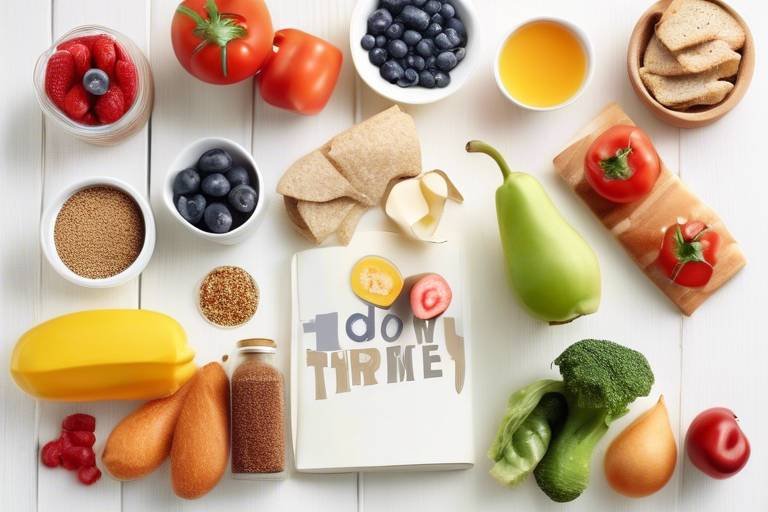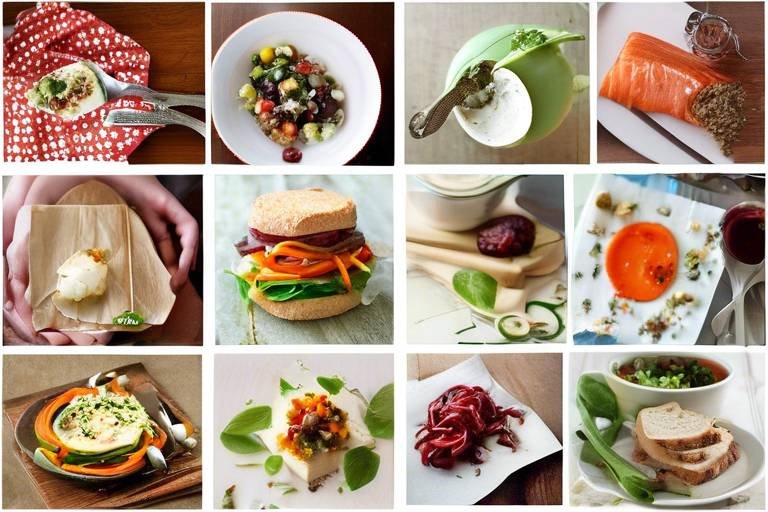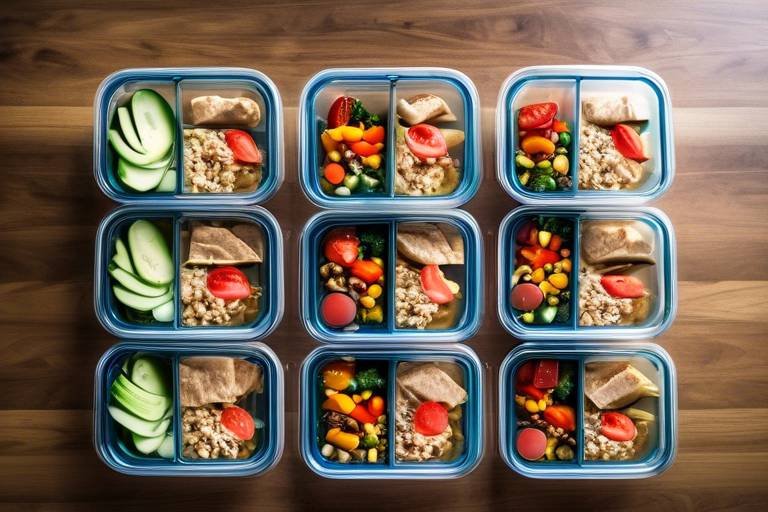Weekly Family Meal Plans: A Month of Options under $100
Are you tired of scrambling for dinner ideas after a long day? Or maybe you're frustrated with how quickly your grocery budget disappears? Well, you’re in the right place! This article presents a comprehensive guide to budget-friendly meal planning for families, featuring a month’s worth of nutritious and delicious meal options that can be prepared for under $100. Imagine having a month’s worth of meals planned out, saving you both time and money while ensuring your family eats well. Sounds like a dream, right? Well, it’s about to become your reality!
Meal planning is not just about saving a few bucks; it’s about transforming your entire approach to family meals. Think of it as a roadmap that guides you through the often chaotic landscape of daily cooking. With a little organization, you can avoid the last-minute takeout temptation and enjoy home-cooked meals that are both satisfying and healthy. Plus, by sticking to your budget, you’ll be able to allocate funds for other important family activities or savings goals.
But how do you get started? First, let’s dive into the benefits of meal planning. Not only does it save you precious time during the week, but it also helps you make healthier choices. When you know what you’re going to eat, you’re less likely to reach for unhealthy snacks or fast food. It’s like having a personal chef who knows exactly what you want, minus the hefty price tag!
Throughout this article, we’ll cover everything from budgeting for groceries to kid-friendly recipes that everyone will love. You’ll find that meal planning can be a fun and creative process, allowing you to explore new flavors and dishes while keeping your family’s preferences in mind. So, buckle up as we embark on this culinary adventure that will not only tantalize your taste buds but also keep your wallet happy!

Benefits of Meal Planning
Meal planning is not just a trendy concept; it’s a game-changer for families looking to save time, money, and even their sanity in the kitchen. Imagine walking into your kitchen knowing exactly what you’re going to cook for the week. No more last-minute dashes to the grocery store or staring blankly at the fridge wondering what to make for dinner. With a solid meal plan, you can streamline your cooking routine and make mealtime a stress-free experience.
One of the most significant benefits of meal planning is the potential for cost savings. By planning your meals in advance, you can make smarter grocery purchases, buy in bulk, and take advantage of sales. This not only helps you stick to your budget but also ensures that you’re buying items that you will actually use. It’s like having a financial roadmap for your grocery shopping!
Additionally, meal planning promotes healthier eating habits. When you take the time to prepare meals ahead of time, you’re less likely to resort to unhealthy takeout or processed foods. Instead, you can focus on incorporating nutritious ingredients into your meals. Think of it as a way to take control of your family’s diet, ensuring that everyone gets the vitamins and minerals they need to thrive.
Another advantage is the reduction of food waste. According to studies, a significant percentage of food purchased goes uneaten, leading to unnecessary waste and financial loss. By planning your meals, you can use up ingredients before they spoil and find creative ways to repurpose leftovers. This not only benefits your wallet but also the environment, making meal planning a win-win situation.
Moreover, meal planning can enhance family bonding. When you involve your family in the planning process, it becomes a fun activity that everyone can participate in. You can sit down together and discuss what meals everyone enjoys or try out new recipes. This not only gives everyone a sense of ownership over their meals but also creates a wonderful opportunity for shared experiences around the dinner table.
In summary, the benefits of meal planning are vast and impactful. From saving money and promoting healthier eating to reducing waste and fostering family connections, it’s an essential practice for any household. So why not give it a try? You might be surprised at how much easier and enjoyable mealtime can become!

Budgeting for Groceries
When it comes to managing a household, budgeting for groceries can feel like a daunting task. However, with the right strategies in place, you can effectively keep your costs down while still enjoying delicious and nutritious meals. Think of your grocery budget as a roadmap; it guides you to your destination without overspending. So, how do you navigate this path? Let's dive into some practical tips that can help you maximize your grocery spending while sticking to your budget of under $100.
First and foremost, it's essential to establish a clear budget. Knowing exactly how much you can spend each week or month gives you a solid foundation. A good starting point is to break down your budget into categories, such as fresh produce, proteins, grains, and pantry staples. For instance, if your monthly grocery budget is $400, you might allocate:
| Category | Budget Allocation |
|---|---|
| Fresh Produce | $100 |
| Proteins | $120 |
| Grains & Pasta | $80 |
| Pantry Staples | $50 |
| Dairy & Snacks | $50 |
By breaking it down this way, you can easily see where your money is going and make adjustments as needed. Another effective strategy is to prioritize your spending. Focus on purchasing items that are both versatile and nutritious. For example, whole grains like brown rice or quinoa can serve as the base for numerous meals, while beans and lentils provide protein and fiber at a fraction of the cost of meat.
Don't forget about the power of seasonal shopping. Purchasing fruits and vegetables that are in season not only supports local farmers but also saves you money. Seasonal produce tends to be fresher, tastier, and more affordable. You might be surprised at how much you can save just by adjusting your shopping list according to the seasons.
Another tip is to take advantage of sales and discounts. Keep an eye on store flyers and apps for weekly deals. If you notice that a certain item is on sale, stock up! Just be sure to choose items that you know you'll use before they expire. Planning your meals around these sales can also help you stay within budget while enjoying a variety of foods.
Lastly, consider using a grocery app or a simple spreadsheet to track your spending. This way, you can see how much you’ve spent in real-time, which can help you avoid overspending. It’s like having a personal finance coach right in your pocket! By implementing these budgeting strategies, you can take control of your grocery expenses and create delicious meals without breaking the bank.
- How can I save money on groceries without sacrificing quality? Focus on buying in bulk, choosing store brands, and planning meals around sales.
- Is it better to shop weekly or monthly? It depends on your family’s eating habits. Weekly shopping can help you buy fresher produce, while monthly shopping can save time.
- What are some budget-friendly meal ideas? Meals like stir-fries, casseroles, and soups are great for using up ingredients and are often inexpensive to make.

Shopping List Essentials
When it comes to meal planning, having a well-organized shopping list is your secret weapon for success. Think of it as your trusty map guiding you through the grocery store jungle. Without it, you might find yourself wandering aimlessly, picking up items you don’t need and overspending. So, let’s dive into the essentials that should be on your shopping list, ensuring you get everything you need to create delicious meals for your family while sticking to that all-important budget of under $100.
First and foremost, you’ll want to focus on the basics. These are the building blocks of any meal and should always be included in your shopping list:
- Proteins: Look for affordable options like chicken thighs, canned beans, and eggs. These ingredients are not only versatile but also packed with nutrients.
- Grains: Stock up on rice, pasta, and oats. They are cost-effective and can serve as the foundation for many meals.
- Fruits and Vegetables: Aim for seasonal produce, which is often cheaper and fresher. Think about items like carrots, potatoes, apples, and bananas.
- Dairy or Alternatives: Milk, yogurt, or plant-based alternatives can add creaminess and flavor to your dishes.
- Condiments and Spices: Don’t forget about flavor! A few key spices and condiments can elevate even the simplest meals.
Now, let’s talk about planning for variety. It’s easy to fall into a rut when meal planning, so consider adding some fun and exciting items to your list. Think about:
- Frozen Foods: Frozen fruits and vegetables are not only budget-friendly but also retain their nutritional value and can be used in smoothies or stir-fries.
- Canned Goods: Stock up on canned tomatoes, tuna, and soups. They’re great for quick meals and can be used in various recipes.
- Snacks: Healthy snacks like nuts, popcorn, and yogurt can keep your family satisfied between meals without breaking the bank.
To make your shopping experience even smoother, consider creating a table to organize your list by category. Here’s a simple example:
| Category | Items |
|---|---|
| Proteins | Chicken thighs, canned beans, eggs |
| Grains | Rice, pasta, oats |
| Fruits & Vegetables | Carrots, potatoes, apples, bananas |
| Dairy | Milk, yogurt |
| Condiments | Spices, sauces |
| Frozen Foods | Frozen fruits, vegetables |
| Canned Goods | Canned tomatoes, tuna |
| Snacks | Nuts, popcorn |
By categorizing your shopping list, you not only save time at the store but also reduce the temptation to make impulse purchases. Remember, the goal is to create a list that reflects your family's preferences while keeping your budget intact. This way, you’ll be equipped to whip up a variety of meals throughout the month without feeling like you’re eating the same thing over and over again.
In conclusion, a well-thought-out shopping list is essential for successful meal planning. It helps you stay organized, saves you money, and ensures you have all the ingredients needed to create nutritious meals for your family. So, before you head to the store, take a moment to plan and prepare your list. Trust me, your future self will thank you!
Q: How can I save more money on groceries?
A: Look for sales, use coupons, and consider shopping at discount stores or local farmers' markets. Buying in bulk can also help reduce costs.
Q: What if my family has dietary restrictions?
A: Adjust your shopping list to accommodate any allergies or preferences. There are plenty of alternatives available for most ingredients.
Q: How can I keep meals interesting for my family?
A: Experiment with different spices, try new recipes, and involve your family in meal planning to discover new favorites.

Weekly Meal Breakdown
When it comes to meal planning, having a well-structured weekly breakdown can be a game-changer for families on a budget. Not only does it help in organizing your meals, but it also injects a sense of excitement into the dining experience. Imagine sitting down each week and looking forward to what’s cooking! With a budget of under $100 for the entire month, we can whip up a variety of delightful meals that cater to everyone’s taste buds. Here’s a breakdown of the weekly meal options that will keep your family satisfied and nourished.
Starting with Week 1, we’ll kick things off with a classic breakfast of scrambled eggs and toast, paired with a side of fresh fruit. For lunch, how about a hearty vegetable soup with whole grain crackers? Dinner could feature a delicious chicken stir-fry with rice and a medley of colorful veggies. This week is all about comfort and warmth, perfect for those chilly evenings.
Moving on to Week 2, let’s spice things up! Breakfast could include oatmeal topped with sliced bananas and a drizzle of honey. For lunch, consider a turkey and cheese wrap with a side of carrot sticks. Dinner can be a fun taco night with ground beef, lettuce, tomatoes, and cheese, allowing everyone to build their own! The interactive element of taco night can make mealtime more enjoyable for kids.
In Week 3, we’ll focus on vegetarian options. Breakfast can feature smoothies packed with spinach, banana, and yogurt. For lunch, a quinoa salad with black beans, corn, and avocado can provide a refreshing twist. Dinner could be a veggie pizza made with a homemade crust, topped with all your favorite vegetables. This week emphasizes healthy eating without sacrificing flavor or fun!
Finally, Week 4 rounds out the month with some international flair. Start the day with pancakes drizzled with maple syrup. For lunch, a Mediterranean platter of hummus, pita bread, and assorted veggies can be both filling and nutritious. Dinner can take us to Italy with a classic spaghetti dish topped with a homemade marinara sauce. Each meal this week is designed to transport your taste buds around the globe!
Here’s a quick overview of the weekly meal breakdown in a table format:
| Week | Breakfast | Lunch | Dinner |
|---|---|---|---|
| 1 | Scrambled eggs and toast | Vegetable soup | Chicken stir-fry |
| 2 | Oatmeal with bananas | Turkey and cheese wrap | Taco night |
| 3 | Spinach banana smoothie | Quinoa salad | Veggie pizza |
| 4 | Pancakes | Mediterranean platter | Spaghetti with marinara |
By following this structured weekly meal breakdown, you not only ensure that your family enjoys a variety of meals but also make the most of your budget. Each week brings new flavors and experiences, turning mealtime into a delightful adventure. So, roll up your sleeves, gather your ingredients, and let the cooking fun begin!
Q: How can I ensure my meals stay under $100 for the month?
A: By planning your meals ahead of time and sticking to a shopping list, you can avoid impulse buys and focus on the essentials.
Q: What if my kids are picky eaters?
A: Get them involved in the meal planning process! Allowing them to choose meals or help in the kitchen can make them more excited about trying new foods.
Q: Can I freeze leftovers?
A: Absolutely! Freezing leftovers is a great way to reduce waste and save money. Just be sure to label and date your containers.
Q: How do I keep my meals interesting?
A: Experiment with different spices, sauces, and cooking methods. Changing up the way you prepare dishes can make a huge difference in flavor!

Kid-Friendly Recipes
Finding meals that your kids will actually eat can feel like trying to solve a Rubik's Cube blindfolded! But fear not, because we’ve got some delicious and nutritious recipes that will make mealtime a breeze for parents and a delight for the little ones. The key is to keep things fun and colorful, incorporating ingredients that are not only healthy but also appealing to young taste buds.
Let’s start with breakfast. Kids love pancakes, and you can easily whip up a batch of banana pancakes that are both fluffy and tasty. Simply mash 2 ripe bananas, mix them with 2 eggs, and cook them on a skillet. Voila! You have a healthy breakfast that’s naturally sweetened and packed with nutrients. Serve them with a drizzle of honey or a sprinkle of cinnamon to make them even more enticing.
For lunch, how about some DIY mini pizzas? Grab some whole wheat pita bread, spread a layer of tomato sauce, and let the kids top their pizzas with their favorite ingredients like shredded cheese, bell peppers, and olives. Not only does this allow them to customize their meals, but it also sneaks in some veggies! Bake them for about 10 minutes, and you’ll have a fun and engaging meal that everyone will love.
Dinner can be another adventure with taco night. Set up a taco bar with ground turkey or beans, shredded lettuce, diced tomatoes, and cheese. Let the kids build their own tacos! This not only makes dinner interactive, but it also encourages them to try new toppings. Plus, it’s a great way to incorporate some protein and fiber into their diet.
Snacks are important too, and kids often crave something crunchy. Try making homemade trail mix with a combination of nuts, seeds, and dried fruit. You can even throw in some dark chocolate chips for a touch of sweetness. Not only is it easy to prepare, but it also provides a healthy energy boost during those afternoon slumps.
To make meal prep even easier, consider batch cooking. For instance, you can prepare a large pot of vegetable soup at the beginning of the week. Load it up with carrots, peas, and any other veggies your kids enjoy. Serve it with whole grain bread for a comforting and nutritious meal that can be enjoyed multiple times throughout the week.
Finally, remember that presentation matters! Kids are more likely to eat something that looks fun. Use cookie cutters to make sandwiches into fun shapes, or arrange fruits and veggies into colorful patterns on their plates. The more appealing the meal looks, the more likely they are to dive in!
Q: How can I encourage my kids to try new foods?
A: Try involving them in the cooking process. Let them choose a new recipe or ingredient at the grocery store, and make it together. Kids are often more willing to try things they’ve helped prepare!
Q: What if my child is a picky eater?
A: Start with small portions of new foods alongside their favorites. It can take several exposures to a new food before they’re willing to try it. Keep it low-pressure and make the experience fun.
Q: Are there any quick recipes I can make for busy weeknights?
A: Absolutely! One-pot meals like stir-fries or casseroles can be prepared quickly and are easy to clean up. You can also prep ingredients over the weekend to save time during the week.

Quick and Easy Preparation
In the hustle and bustle of family life, finding time to prepare meals can often feel like a daunting task. However, with a little planning and some clever strategies, you can whip up delicious dishes without spending hours in the kitchen. Think of meal preparation as a fun puzzle; with the right pieces in place, everything falls into place beautifully!
One of the best ways to streamline your cooking process is by batch cooking. This means preparing larger quantities of certain dishes that can be easily reheated throughout the week. For example, you could make a big pot of chili or soup on the weekend and store it in portions. Not only does this save time, but it also ensures you always have a healthy option ready to go. Imagine coming home after a long day and just having to heat up a meal instead of starting from scratch!
Additionally, prepping ingredients ahead of time can significantly cut down on cooking time during the week. Spend a little time on Sunday chopping vegetables, marinating proteins, or even cooking grains like rice or quinoa. Store these in clear, labeled containers in the fridge, so they’re easy to grab when you’re ready to cook. It’s like having your own little assembly line right in your kitchen!
Another quick tip is to utilize one-pot meals. These recipes not only save you time on cooking but also on cleanup. Think of hearty stir-fries, casseroles, or pasta dishes where everything cooks in one pot or pan. You can throw in whatever ingredients you have on hand, making it a flexible option that fits your family’s taste buds. Plus, it reduces the number of dishes you have to wash afterward—win-win!
For those busy weekdays, consider using slow cookers or instant pots. These appliances are game-changers for families on the go. You can throw in your ingredients in the morning, set it, and forget it! By the time dinner rolls around, you’ll have a hot, home-cooked meal waiting for you. It’s like having a personal chef who works while you’re out living your life!
Lastly, don't underestimate the power of simple recipes. Sometimes, the best meals are the simplest. Focus on fresh, whole ingredients and let their natural flavors shine. A quick sauté of seasonal vegetables with olive oil and garlic can be a delightful side dish, while grilled chicken seasoned with herbs makes for a satisfying main course. Remember, cooking doesn’t have to be complicated to be delicious!
In summary, by incorporating these quick and easy preparation techniques into your routine, you can make family mealtime enjoyable rather than a chore. With a little creativity and some smart planning, you can serve up nutritious meals that everyone will love, all while keeping your kitchen time to a minimum.
Q: How can I make meal prep easier for my family?
A: Start by planning your meals for the week, prepping ingredients in advance, and utilizing batch cooking and one-pot meals to save time.
Q: What are some good one-pot meals to try?
A: Consider dishes like chili, stir-fries, or pasta bakes. These meals are versatile and can be customized to your family's tastes.
Q: Can I use a slow cooker for any recipe?
A: While many recipes can be adapted for a slow cooker, it's best to look for recipes specifically designed for it to ensure proper cooking times and textures.

Leftover Utilization
Leftovers can often feel like a burden, but they are actually a hidden treasure in your kitchen! Instead of viewing them as a chore, think of them as an opportunity to create something new and exciting. By effectively utilizing leftovers, you can stretch your grocery budget even further and reduce food waste, which is a win-win for both your wallet and the environment.
One of the best ways to use leftovers is by transforming them into completely different meals. For example, if you have leftover roasted chicken, you can shred it and use it in a chicken salad, toss it into a soup, or even use it as a topping for a pizza. The key is to think creatively! Here are some ideas to inspire you:
- Stir-fry: Leftover vegetables and proteins can be quickly sautéed with some soy sauce and served over rice or noodles for a delightful stir-fry.
- Wraps: Use leftover meat or veggies as fillings for wraps. Add some hummus or yogurt for extra flavor.
- Frittatas: Whip up a quick frittata using leftover veggies, meats, and cheeses. It’s perfect for breakfast, lunch, or dinner.
Additionally, consider incorporating your leftovers into new recipes. For instance, if you have leftover spaghetti, turn it into a delicious spaghetti pie by mixing it with eggs and cheese, baking it until golden brown. Not only does this give a second life to your food, but it also keeps your meal rotation exciting. You can even create a leftover night once a week, where everyone gets to choose their favorite leftover dish. This not only reduces waste but also allows the family to bond over a fun and creative meal.
Moreover, proper storage is crucial for maximizing the lifespan of your leftovers. Make sure to store them in airtight containers to keep them fresh. Label your containers with dates to ensure you use them while they’re still good. A simple table can help you keep track of what you have in your fridge:
| Leftover Item | Date Stored | Use By Date |
|---|---|---|
| Roasted Chicken | 10/01/2023 | 10/05/2023 |
| Vegetable Stir-fry | 10/02/2023 | 10/06/2023 |
| Spaghetti | 10/03/2023 | 10/07/2023 |
Lastly, don’t forget about snacks! Leftover fruits can be blended into smoothies, or you can use leftover bread to make croutons for salads. The possibilities are endless! By being resourceful and thinking outside the box, you can turn what might have been wasted into delicious meals that your family will love.
Q: How long can I keep leftovers in the fridge?
A: Generally, leftovers can be stored in the fridge for 3-4 days. After that, it's best to freeze them or discard them to ensure food safety.
Q: Can I freeze leftovers?
A: Yes! Most leftovers can be frozen for later use. Just make sure to label them with the date and type of food before freezing.
Q: How can I make sure my leftovers taste fresh?
A: Reheating leftovers in the oven or on the stovetop can help maintain their texture and flavor better than microwaving. Adding a splash of broth or sauce can also help revive dried-out dishes.

Healthy Snacking Ideas
Let’s face it: snacking is a part of life, especially for families on the go. But before you reach for that bag of chips or sugary treat, consider the benefits of healthy snacking. Not only can nutritious snacks keep your energy levels up, but they can also prevent those hunger pangs that lead to unhealthy meal choices later on. So, what are some quick and easy options that won’t break the bank? Let’s dive into some delicious and budget-friendly ideas!
First off, think about incorporating fruits and vegetables into your snack routine. They’re not just healthy; they’re also vibrant and full of flavor! For example, you can slice up some carrots and cucumbers, and pair them with a homemade hummus dip. Not only is this a fun way to enjoy your veggies, but it also packs a protein punch. If you’re looking for something sweeter, grab some apples or bananas. They are perfect for a quick grab-and-go snack. You can even spread a little peanut butter on apple slices for that extra oomph!
Another fantastic option is to prepare energy balls at the beginning of the week. These little bites of goodness are super easy to make and can be customized to your taste. Typically made from oats, nut butter, honey, and your choice of mix-ins like chocolate chips or dried fruits, they’re a hit with both kids and adults. Just roll them into small balls, and you’ve got a snack that’s ready to fuel your family’s adventures!
Now, let’s not forget about yogurt. It’s not just a breakfast item! Yogurt can be a fantastic base for a nutritious snack. Consider topping plain yogurt with some granola and fresh berries for a delightful treat. This combination is not only tasty but also provides a good mix of carbohydrates and protein. Plus, it’s a great way to sneak in some probiotics for gut health!
And speaking of protein, don’t overlook nuts and seeds. They are nutrient-dense and can be very filling. A handful of almonds or sunflower seeds can stave off hunger and provide healthy fats that are essential for your body. Just be mindful of portion sizes, as they can be calorie-dense. If you’re feeling adventurous, try making your own trail mix by combining nuts, seeds, and a few pieces of dried fruit. This way, you can control the ingredients and keep it healthy!
For those moments when you need something crunchy, consider making popcorn. Air-popped popcorn is a whole grain and can be a great snack when seasoned correctly. Try adding a sprinkle of nutritional yeast for a cheesy flavor or a dash of cinnamon for sweetness. It’s a fun way to enjoy a classic snack while keeping it healthy and budget-friendly.
Incorporating these healthy snacking ideas into your family’s routine can make a world of difference. Not only do they provide essential nutrients, but they also keep everyone satisfied and energized throughout the day. Remember, the key is to keep things varied and fun—after all, snacking should be an enjoyable experience!
- What are some quick healthy snacks for kids?
Some quick options include yogurt with fruit, nut butter on whole grain toast, or veggie sticks with hummus.
- How can I make healthy snacks more appealing to children?
Try involving them in the preparation process, using fun shapes with cookie cutters, or creating colorful fruit kabobs.
- Are store-bought snacks unhealthy?
Many store-bought snacks can be high in sugar and preservatives. Always check the label and opt for those with fewer ingredients.

Tips for Staying on Track
Staying on track with your meal planning can sometimes feel like trying to keep a sandcastle intact at high tide. It’s easy to get swept away by the chaos of daily life, but with a few practical strategies, you can maintain your focus and make the most of your budget-friendly meal plans. First off, consistency is key. Try to set aside a specific time each week to plan your meals and create your shopping list. This routine becomes a habit, and soon enough, it’ll feel second nature.
Another effective tip is to keep your meal plan visible. Whether it’s a whiteboard on the fridge or a digital note on your phone, having a visual reminder of your meals for the week can help keep you accountable. You could even use colorful markers or stickers to make it fun! Plus, it’s a great way to involve the whole family. Ask your kids to help pick meals or even choose a night to cook together. This not only makes mealtime exciting but also encourages them to try new foods.
Now, let’s talk about flexibility. Life can throw unexpected curveballs, and sometimes your best-laid plans need a little adjustment. If you find yourself with a busy evening, don’t hesitate to swap a more complicated recipe for something simpler. Embrace the idea of “planned leftovers” where you intentionally cook extra portions to save time later in the week. This not only reduces stress but also minimizes food waste, allowing you to stretch your budget even further.
Another handy tip is to utilize a shopping app or a simple spreadsheet to track your grocery expenses. This way, you can easily see how much you’ve spent and how much you have left in your budget. You can even categorize your expenses into essentials and treats, which can help you prioritize your spending. For instance, if you find yourself splurging on snacks, you might decide to cut back and allocate that money towards fresh produce instead.
Lastly, don’t forget to celebrate your successes! Each week you stick to your meal plan and budget is a mini victory. Consider keeping a journal or a digital log of your meal planning journey. Reflecting on what worked well and what didn’t can provide valuable insights for future planning. Plus, it’s a great way to keep track of your family’s favorite meals, making it easier to repeat the hits!
Q: How can I make meal planning easier for my family?
A: Start by involving your family in the planning process. Let them choose meals, which can make everyone more excited about what’s for dinner. Consider creating a rotating meal schedule to simplify choices.
Q: What if I go over my $100 budget?
A: It happens! Review your shopping list and see where you might have overspent. Adjust your meals for the upcoming week based on what you have left over and look for sales or discounts to help you save.
Q: How can I make sure my kids eat the meals I prepare?
A: Get them involved in the cooking process! Kids are more likely to eat what they help make. You can also try to incorporate their favorite ingredients into the meals to make them more appealing.
Q: What are some quick meals I can prepare on busy nights?
A: Think about simple stir-fries, pasta dishes, or sheet pan meals that can be prepped in under 30 minutes. Having a few go-to quick recipes can save you on those hectic days!
Frequently Asked Questions
- What are the main benefits of meal planning?
Meal planning can save you both time and money while promoting healthier eating habits. By organizing your meals in advance, you can reduce stress during busy weekdays, minimize food waste, and ensure that your family enjoys a balanced diet.
- How can I effectively budget my grocery expenses?
To effectively budget your grocery expenses, start by setting a clear budget, like $100 for the month. Prioritize your spending by focusing on essential items, using sales and coupons, and planning meals around seasonal produce to maximize your dollar. Keeping track of your expenses can also help you stay on target.
- What should I include in my shopping list?
Your shopping list should consist of essential items that will help you create a variety of meals. Include staples like grains, proteins, fruits, and vegetables. Don't forget to add pantry essentials such as spices, oils, and condiments to enhance your meals.
- Can you provide examples of kid-friendly recipes?
Absolutely! Some kid-friendly recipes include homemade pizza with whole wheat crust, colorful veggie wraps, and fruit smoothies. These meals are not only nutritious but also fun for kids to help prepare, making mealtime a family affair.
- How can I quickly prepare meals during the week?
To speed up meal preparation, consider batch cooking on weekends, using a slow cooker, or prepping ingredients in advance. Simple recipes that require minimal cooking time, like stir-fries or salads, can also help you whip up meals in no time!
- What are some creative ways to use leftovers?
Leftovers can be transformed into new meals! For example, roasted chicken can become chicken salad, and extra vegetables can be tossed into a stir-fry or soup. Get creative and think of leftovers as building blocks for new dishes.
- What are some healthy snack ideas for families?
Healthy snacks can include fresh fruits, yogurt, nuts, and homemade granola bars. These options are not only budget-friendly but also easy to prepare, keeping your family energized and satisfied throughout the day.
- How can I stay on track with my meal plan?
To stay on track with your meal plan, regularly review your grocery list and meals, make adjustments as needed, and keep your family involved in the planning process. Setting reminders and planning meals around your schedule can also help you stick to your budget.



















